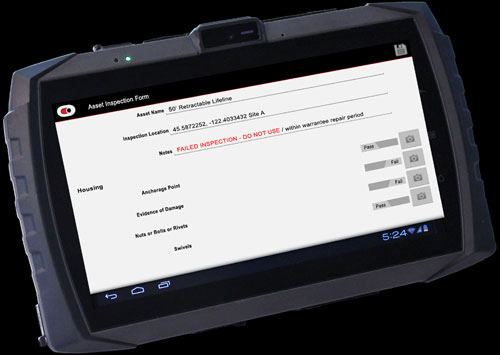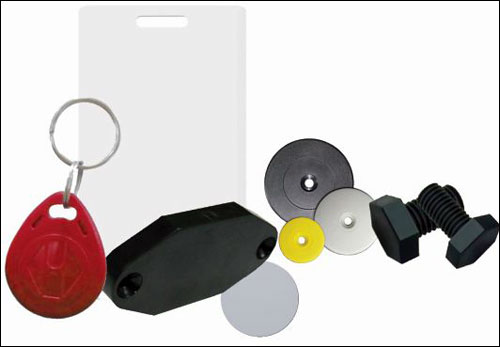May 16, 2014Havoc, a startup based in Gig Harbor, Wash., has launched a high-frequency (HF) RFID solution with ruggedized hardware for tracking inventory, inspections and maintenance on fall-protection and other safety equipment, as well as additional assets used on construction sites. The system consists of cloud-based software known as SuperTrack.CT, in addition to 13.56 MHz HF RFID readers and tags, both encased in material designed to prevent damage at a worksite.
Safety products company Guardian Fall Protection is the first adopter of Havoc's technology, using the firm's readers and software for its G-Track system for tracking inventory, as well as product inspection and maintenance, at job sites. Guardian has been working with RFID technology for several years, in an effort to develop a solution that would improve worksite safety by making it easier for safety directors to track the locations and conditions of its gear, says Ed Marquardt, Guardian Fall Protection's president. However, the RFID hardware and software available on the market fell short of what he needed. The systems were designed for industrial or oil and gas operations, he explains, and not specifically for the use case of Guardian's clientele—construction companies, general contractors and the distributors that serve them.

Eric Lewis, who shared business contacts with Guardian, founded Havoc in 2012 to meet the needs of Guardian and other construction-industry companies. Lewis had several decades of experience with the RF equipment used in two-way radios. Havoc's HF readers and tags are ruggedized for deployment at construction sites, while the cloud-based software enables users to store data specific to their safety gear at construction sites—including where each item is being used or stored, so that it can be easily located.
According to Marquardt, several of Guardian's customers are now using the G-Track system, which became commercially available this month.
Guardian manufactures a wide range of harnesses, lanyards, lifelines and anchor points. The American National Standards Institute (ANSI) and the Occupational Safety and Health Administration (OSHA) both require that construction companies regularly inspect items (typically every six months) to ensure that they are safe to operate, and also can dictate when those assets need to be discarded. Safety-equipment manufacturers, such as Guardian, also provide users with their own recommendations regarding a particular item's lifespan and how often it should be inspected or maintained.
Guardian sought an RFID-based solution to enable it and its customers to better track this information, as well as present it to regulatory agencies. The solutions that Guardian identified, however, would have required some customization to meet the ruggedization needs of its customers, and those providers were unable to offer such customization. Therefore, the firm began working with Havoc.
Without an RFID-based system, Marquardt notes, safety equipment is often not inspected as it should be and, as a result, becomes unsafe—which opens a contractor up to liability issues. "I tell people 'You wouldn't drive with a tire that only had one lug nut, would you?'" he says, which he characterizes as synonymous with sending employees to work with safety equipment that is not operating properly.
G-Track consists of Havoc's RFID tags (compliant with the ISO 15693 standard), Havoc's tablet or USB RFID readers, and the cloud-based software. Guardian's manufacturers sew a tag into each product, and Guardian then interrogates those tags when it receives shipments of goods from its suppliers, and again as it ships them to its own customers or distributors. In that way, the company knows not only what inventory it has on hand, but also which items were sent to which recipients, thereby creating a record that could be accessed in the event of a recall.

Guardian's customers are using the SuperTrack.CT software and Havoc readers to identify the location of equipment, and to receive alerts indicating which items require inspection or maintenance. Inspectors can then utilize a reader to store a record of the services they provide for each asset.
Havoc is providing the RFID solution not only to Guardian, but also to other equipment manufacturers—which can rebrand the technology under their own name—as well as to construction companies and other end users. Lewis says the company opted to provide HF RFID technology, rather than ultrahigh-frequency (UHF), partly because it operates well around metal, but also because a short read range is more appropriate for this particular use case. For example, he says, if an inspector wished to inspect a single asset but walked into a storage area at a job site that housed hundreds of that specific item, it would be impossible to avoid reading tags attached to unintended objects. What's more, he adds, as a growing number of Near Field Communication (NFC) mobile phones arrive on the market, the system is designed to enable users to read the tags via an NFC-enabled smartphone, despite the different ISO standard (NFC uses ISO 14443). "We have successfully tested our tags with all current and popular Android phones with NFC," Lewis says, "so I believe it is commonplace that NFC chipsets will read both." Users would simply need to download an application from Havoc to manage the collected read data.
With the Havoc cloud-based software in place, authorized personnel at an end user's site—in a construction area, for instance—can access the manufacturing data being stored with a particular tag's ID number. Workers can then interrogate that tag using a Havoc reader to enable the inputting of additional information, such as maintenance and inspection work performed on that piece of equipment, where the asset is being moved to or to whom it is being assigned.
Havoc offers its Scanning Armored (SCAR) heavy-duty tablets with a built-in HF RFID reader, as well as two cameras and Bluetooth, Wi-Fi and GPS functionality. It also sells its SuperScan USB RFID reader, which can be plugged into the USB port of a laptop of tablet. The tags are made with NXP Semiconductors' ICode SLI series of chips built into them, and are designed to be waterproof, dustproof and shockproof, and to last 10 years or more.

